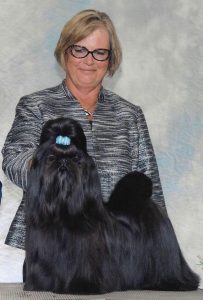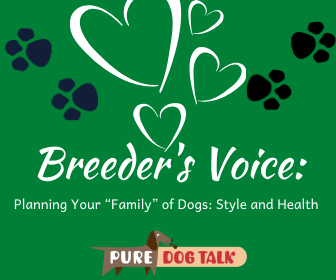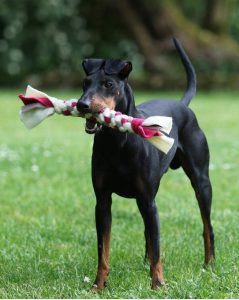397 — Planning Your “Family” of Dogs: Style and Health
Planning Your “Family” of Dogs: Style and Health
Our topic is breeding. With an emphasis on planning your family of dogs. The question: is consistency of style more important than consistency of health and/or quality? How do you get to your desired goals?
Today’s guests are Amanda Kelly, Wendy Paquette and Chris Heartz. This is part one of a two part series. Check back next week for part two!
Type to type
 Wendy: “Coming from a background of Shih Tzu, that were only recognized in United States in 1969, I didn’t have much choice when I first started my breeding program. Living in northern Ontario, the only way I could buy a female was to import two from England ’cause they were just not available. Luckily I came across Luc Boileau in Montreal who was showing English imported dogs at the time. So I was able to take my English import and breed it to one of Luc’s dogs. But that left me sort of in a quandary because I had nowhere else to go after that. So I basically started out breeding type to type.
Wendy: “Coming from a background of Shih Tzu, that were only recognized in United States in 1969, I didn’t have much choice when I first started my breeding program. Living in northern Ontario, the only way I could buy a female was to import two from England ’cause they were just not available. Luckily I came across Luc Boileau in Montreal who was showing English imported dogs at the time. So I was able to take my English import and breed it to one of Luc’s dogs. But that left me sort of in a quandary because I had nowhere else to go after that. So I basically started out breeding type to type.
“Consistency of type was a goal, but health and welfare, to me, is a major factor. If you don’t have health and welfare you don’t have quality and type either.
“I have done inbreeding, outcrossing, line-breeding. I’ve done it all throughout the years. It’s easier to do stuff like that if you have quantity of dogs. So there was a point where I had up to 50 Shih Tzu. So I could pick and choose what direction I wanted to take each line.”
Health in a small gene pool
 Amanda: “I think it depends on where your breed is. Every breed is going to be unique. How you approach setting up your own breeding program and also thinking about management of the population as a whole. So there’s a lot of things that come into play in that respect.
Amanda: “I think it depends on where your breed is. Every breed is going to be unique. How you approach setting up your own breeding program and also thinking about management of the population as a whole. So there’s a lot of things that come into play in that respect.
“As breeders, when we talk about getting consistency and cultivating aspects of breed type, we’re often talking about eliminating genetic material. In order to concentrate the genes so that we can get the head that we like or the coat that we like, we’re limiting the genes for the other things.
“(In) very small breeds, we have to not only think about what we want in our own breeding program, but also what is the best choices to make in order to cultivate the things that we think our breed needs now or may need in the future.
Cookie cutters
 Chris: “I sometimes get upset when I put a dog on the table and somebody who I maybe don’t know looks at me and says ‘Another cookie cutter.’ And it drives me crazy because I think of how many disappointments, how many hurdles we had to cross (to get our) cookie cutter right.
Chris: “I sometimes get upset when I put a dog on the table and somebody who I maybe don’t know looks at me and says ‘Another cookie cutter.’ And it drives me crazy because I think of how many disappointments, how many hurdles we had to cross (to get our) cookie cutter right.
“I was lucky enough that instead of a diamond, my husband gave me a dog as an engagement present. That dog was everything we wanted. He wasn’t perfect, but he was where we felt the breed needed to go. He had beautiful shoulders. He had reach and drive. He had a body shape that was not so common because he was actually short backed. We knew the blueprint but we made some mistakes and made some assumptions along the way.
“I have it in big bold letters: if you own a stud dog, he is not always the best breeding for your bitch. It took a long time to figure that out. I see people do it all the time. You have to know what clicks, what doesn’t click and what never to breed together.”
337 – Black & Tan Dynamos: The Wash & Wear Manchester
Black & Tan Dynamos: The Wash & Wear Manchester
The Manchester Terrier has two varieties, Standard and Toy, both descended from the extinct black and tan terrier, according to a panel of experts at the American Manchester Terrier Club National Specialty.
The Manchester’s job was to hunt rats and other vermin in England and they retain the high prey drive today. Our experts encourage new owners to be sure their Manchester is on lead when outside a fenced area.
“You can have a good recall, but a squirrel will always take precedence,” said Marla Zoz.
Key Manchester Points:
- High drive, are food motivated but easily distracted.
- Very smart, pick up new skills quickly.
- Get very attached to their people. Suitable for a house or apartment.
- Need lots of physical activity.
- Require a lot of attention.
- Love being a part of the family.
- Need to spend time to develop well balanced companion.
- Low maintenance grooming… nails, clean teeth, wash and wear.
- Longevity – 15+ years.
- Health issues include cardiomyopathy and vWD, a bleeding disorder. When visiting with a potential breeder, be sure to ask if he/she is testing for these conditions with available DNA tests.
Standard Manchester Terriers are allowed to have naturally erect ears, button (shown here) or cropped. Toy Manchesters are only shown with naturally erect ears.
“You want to go, they’re ready at a moment’s notice. You want to cuddle on the couch, they’re right there,” said Jim Burrows.
These dogs are terriers, whether standard or toy sized, our panelists noted. They can “talk a lot.” Everyone agreed that the “four-footed burglar alarm” breed can be vocal. “They’re going to bark if they see something they don’t know,” Burrows said.
While generally aloof with strangers, the Manchester will warm up to new folks quickly. The breed needs a lot of socializing to develop a well-rounded dog, the breeders all agreed. Dog aggression, typical of many terriers, is manageable with appropriate socializing and training.



